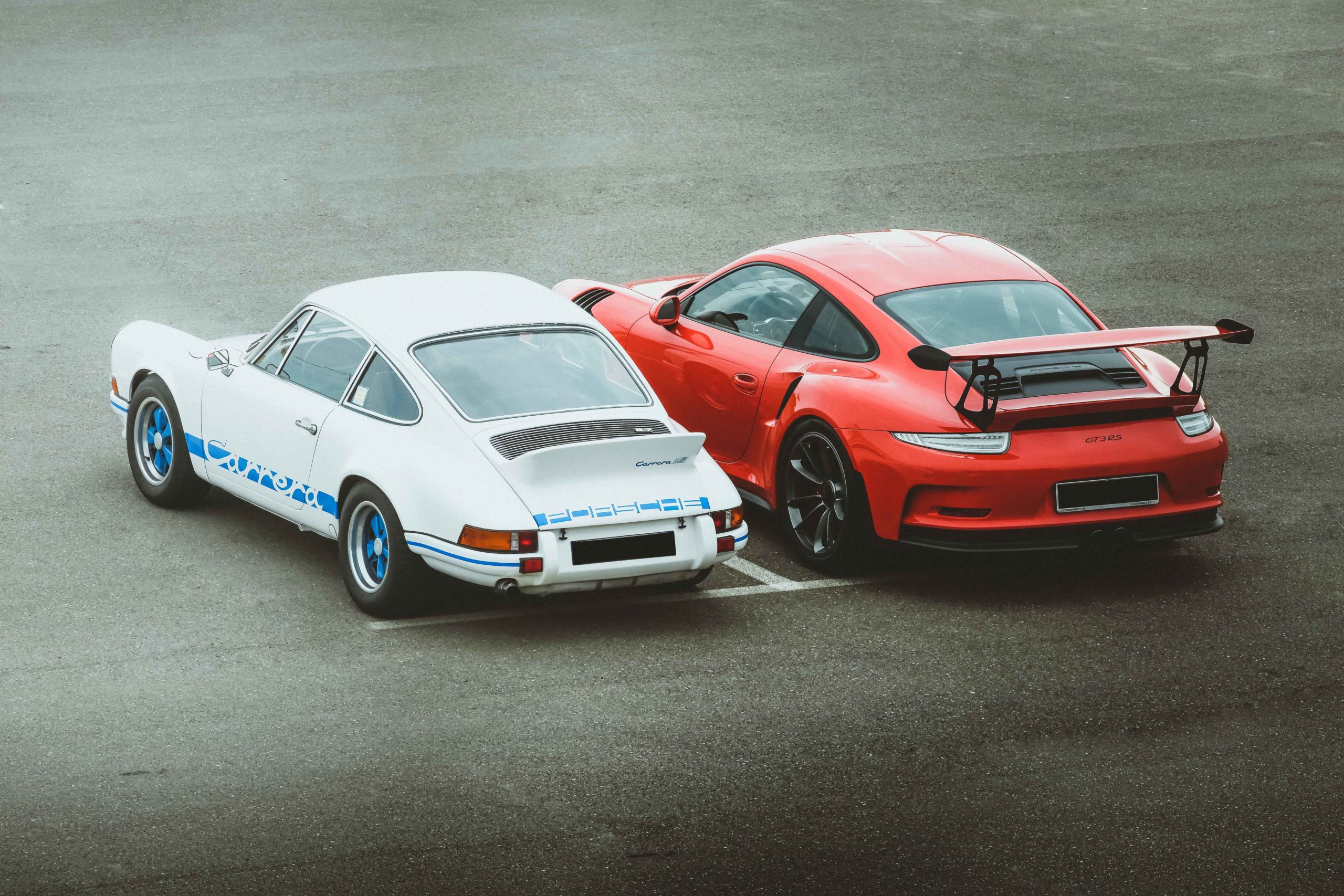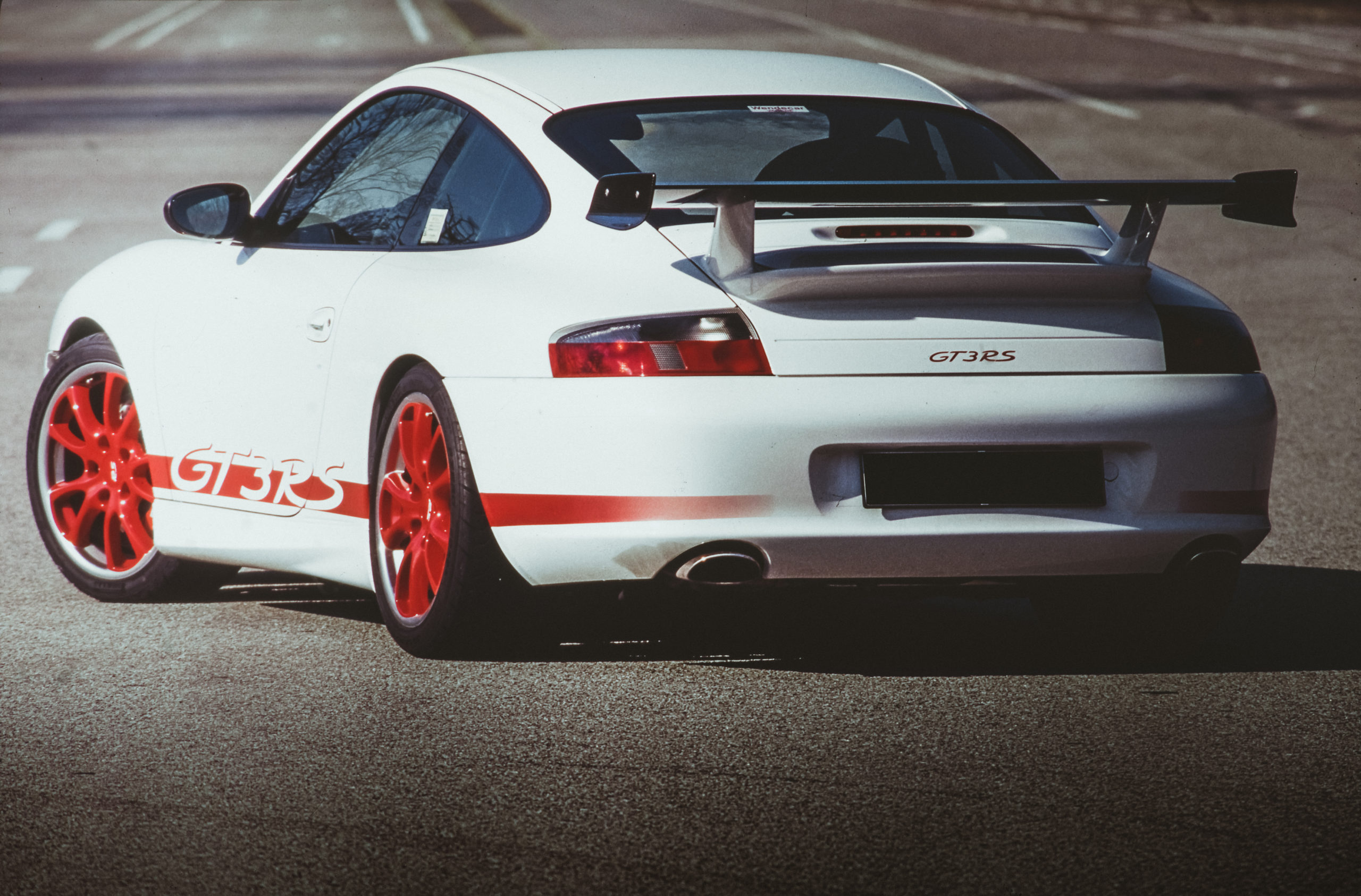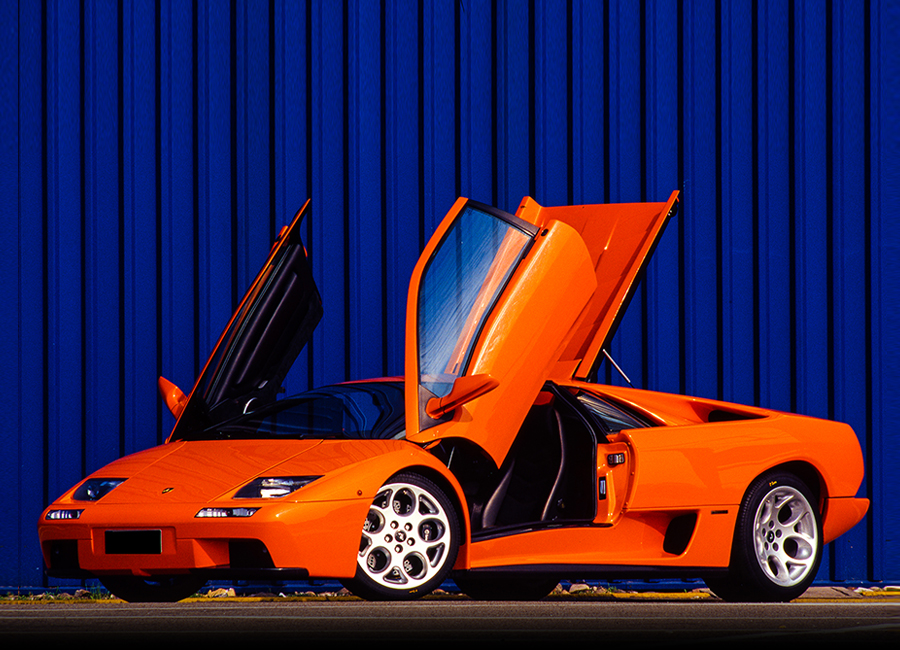RS
Rennsport is the concise expression coined by Porsche to indicate their close-to-the-race sports cars, which most often appears in the abbreviation RS. The common denominator of all Porsches bearing the RS badge on their flat-six engine cover is lightness and performance. Together with a “weight-reduction program” Porsche also prescribes a vitamin treatment for the engines mounted on RS cars, on which everything unnecessary has been eliminated.
In the collective imagination, RS means pure driving pleasure, the challenge of controlling extreme performances unfiltered by electronic gadgets: this series was born to be most exciting 911, developed for competitions and produced in limited-series to get the racing homologation. Everything on these cars is designed especially with the aim of optimizing dynamic output so as to provide those capable of handling them with genuine racetrack emotions. Lightness is the watchwords and, in a race-car (even if road-legal), comfort is superfluous, so interiors were essential, provided by a simple pull-strap instead of door handle – this feature marked all generations, from the first 2.7 to latest 992 GT2 RS.
The founder of the line is the legendary Carrera RS 2.7, unveiled in 1972 and built-in 1580 examples (of which 200 were very raw, with bare and Spartan interior) in Lightweight/Sport version and Touring/Comfort trim. From this first series, the design of the following RS has always been distinguished by the search for improved aerodynamics, with the application of spoilers and wings – well known are the 2.7 “ducktail” or the enormous GT3 RS rear wing. In parallel with the aerodynamic research, the look also becomes more aggressive: lower bodies and wider tracks – and thus also wider fenders – have given these Porsches an irresistible appeal for motorsport lovers.
The ideal terrain for the use of these high-performance cars is, of course, the track: it is the only place where they can truly exploit their elevated potentials even if, like all Porsches, RS are also touring and city cars, able to run even at lower rpm. There may be a certain amount of discomfort, perhaps few decibels more of engines noise in the cockpit, but optional like A/C, radio and standard seats (instead of the Recaro bucket) were available also for these extreme cars. Indeed the 2.7 RS Touring has a “comfort” package provided by the 2.4 S style interiors, which gave standard door furniture, carpets and back seats, to become more civilized!
After the first 2.7 RS, beloved for its brutal power, Porsche decided to dust off the alluring Rennsport badge almost twenty years later, in 1991. With the 964 Carrera RS 3.6 followed the philosophy of reducing weight, removing everything judged unnecessary from the car. With 10hp more and 150kg less, the 964 RS was faster, more agile and responsive than a “normal” Carrera 2, which really looks like also due to the lack of the rear spoiler. In 1993 the displacement was enlarged to 3.8, the power brought to 300hp and the bodywork restyled, now featuring an aeronautical size rear wing – described by Paul Frère as “virtually a road-legal version of the Carrera Cup model”.
In May 1995, the ultimate evolution of the normally aspirated Porsche 993 model made its debut with the limited-production 993 Carrera RS 3.8. It is the last pre-996 air-cooled Porsche and, another time, it was built for Motor Sport Homologation, to allow the enlarged 3.8 engine to be fitted in the 911 RSR race car. 100kg was overall earned from 993 base model thanks to the elimination of unnecessary details and the reconstruction of lighter parts, such as the aluminium front hood and plastic engine cover. New multipiece wheels “Speedline for Porsche” was adopted: 18” light alloy with magnesium centres. For this track-focused 993 RS Porsche offered the RSR or “Club Sport” pack, which gained more muscle to the bodywork adding a deeper front spoiler with winglets and massive racing style fibreglass wing.
In 2004, reworking the impressive 996 GT3, Porsche perfected its total weapon for the GT Championship, the 996 GT3 RS. Powered by a 3.6 water-cooled engine which supply 381hp, it fitted rear wing grew to race car proportions, extra vent on the top of the front bumpers and was offered in two colour-matched: white body with red or blue GT3 RS script and wheels. Also a 3.6 litres engine was employed for the 2006 GT3 RS 997, upgraded to 3.8 L in 2009 and to 4.0 L for the final evolution in 2011.
Unlike previous RS model, the 991 GT3 RS is powered by a mighty Turbo 4.0 L engine, with 500hp. Following the tradition of saving weight, the 991-generation RS employed innovative materials such as the carbon fibre bonnet and wing, magnesium roof (that allow saving 1.1 kg!) and polycarbonate back windows (saving 3.5 kilograms compared with glass) for a total weight of 1420kg. With his imposing aero kit features and gapings vent over the front wheels, it looks pretty wild! The interior is definitely more civilized, with fixed carbon fibre bucket seats offering quiet OK comfort, aircon and multimedia screen and finished dashboard. There’s also a yellow stripe on the steering wheel to show the straight-ahead position and a pit-lane speed limiter to remind you you’re in a “road-legal” race car!
Almost 50 years have passed from the glorious 1972 2.7 RS – which remains a motorsport milestone – to the present. The power and consequently also the weight increased (from the 210hp and 900kg to 700hp and approx 1400kg of the 2019 GT2 RS!) and what we understand is less stuff there is, the faster it will go!
ENGINEROUTE
RS
Rennsport is the concise expression coined by Porsche to indicate their close-to-the-race sports cars, which most often appears in the abbreviation RS. The common denominator of all Porsches bearing the RS badge on their flat-six engine cover is lightness and performance. Together with a “weight-reduction program” Porsche also prescribes a “vitamin treatment” for the engines mounted on RS cars, on which everything unnecessary has been eliminated.
In the collective imagination, RS means pure driving pleasure, the challenge of controlling extreme performances unfiltered by electronic gadgets: this series was born to be most exciting 911, developed for competitions and produced in limited-series to get the racing homologation. Everything on these cars is designed especially with the aim of optimizing dynamic output so as to provide those capable of handling them with genuine racetrack emotions. Lightness is the watchwords and, in a race-car (even if road-legal), comfort is superfluous, so interiors were essential, provided by a simple pull-strap instead of door handle – this feature marked all generations, from the first 2.7 to latest 992 GT2 RS.
The founder of the line is the legendary Carrera RS 2.7, unveiled in 1972 and built-in 1580 examples (of which 200 were very raw, with bare and Spartan interior) in Lightweight/Sport version and Touring/Comfort trim. From this first series, the design of the following RS has always been distinguished by the search for improved aerodynamics, with the application of spoilers and wings – well known are the 2.7 “ducktail” or the enormous GT3 RS rear wing. In parallel with the aerodynamic research, the look also becomes more aggressive: lower bodies and wider tracks – and thus also wider fenders – have given these Porsches an irresistible appeal for motorsport lovers.
The ideal terrain for the use of these high-performance cars is, of course, the track: it is the only place where they can truly exploit their elevated potentials even if, like all Porsches, RS are also touring and city cars, able to run even at lower rpm. There may be a certain amount of discomfort, perhaps few decibels more of engines noise in the cockpit, but optional like A/C, radio and standard seats (instead of the Recaro bucket) were available also for these extreme cars. Indeed the 2.7 RS Touring has a “comfort” package provided by the 2.4 S style interiors, which gave standard door furniture, carpets and back seats, to become more civilized!
After the first 2.7 RS, beloved for its brutal power, Porsche decided to dust off the alluring Rennsport badge almost twenty years later, in 1991. With the 964 Carrera RS 3.6 followed the philosophy of reducing weight, removing everything judged unnecessary from the car. With 10hp more and 150kg less, the 964 RS was faster, more agile and responsive than a “normal” Carrera 2, which really looks like also due to the lack of the rear spoiler. In 1993 the displacement was enlarged to 3.8, the power brought to 300hp and the bodywork restyled, now featuring an aeronautical size rear wing – described by Paul Frère as “virtually a road-legal version of the Carrera Cup model”.
In May 1995, the ultimate evolution of the normally aspirated Porsche 993 model made its debut with the limited-production 993 Carrera RS 3.8. It is the last pre-996 air-cooled Porsche and, another time, it was built for Motor Sport Homologation, to allow the enlarged 3.8 engine to be fitted in the 911 RSR race car. 100kg was overall earned from 993 base model thanks to the elimination of unnecessary details and the reconstruction of lighter parts, such as the aluminium front hood and plastic engine cover. New multipiece wheels “Speedline for Porsche” was adopted: 18” light alloy with magnesium centres. For this track-focused 993 RS Porsche offered the RSR or “Club Sport” pack, which gained more muscle to the bodywork adding a deeper front spoiler with winglets and massive racing style fibreglass wing.
In 2004, reworking the impressive 996 GT3, Porsche perfected its total weapon for the GT Championship, the 996 GT3 RS. Powered by a 3.6 water-cooled engine which supply 381hp, it fitted rear wing grew to race car proportions, extra vent on the top of the front bumpers and was offered in two colour-matched: white body with red or blue GT3 RS script and wheels. Also a 3.6 litres engine was employed for the 2006 GT3 RS 997, upgraded to 3.8 L in 2009 and to 4.0L for the final evolution in 2011.
Unlike previous RS model, the 991 GT3 RS is powered by a mighty Turbo 4.0 L engine, with 500hp. Following the tradition of saving weight, the 991-generation RS employed innovative materials such as the carbon fibre bonnet and wing, magnesium roof (that allow saving 1.1 kg!) and polycarbonate back windows (saving 3.5 kilograms compared with glass) for a total weight of 1420kg. With his imposing aero kit features and gapings vent over the front wheels, it looks pretty wild! The interior is definitely more civilized, with fixed carbon fibre bucket seats offering quiet OK comfort, aircon and multimedia screen and finished dashboard. There’s also a yellow stripe on the steering wheel to show the straight-ahead position and a pit-lane speed limiter to remind you you’re in a “road-legal” race car!
Almost 50 years have passed from the glorious 1972 2.7 RS – which remains a motorsport milestone – to the present. The power and consequently also the weight increased (from the 210hp and 900kg to 700hp and approx 1400kg of the 2019 GT2 RS!) and what we understand is less stuff there is, the faster it will go!
ENGINEROUTE
































